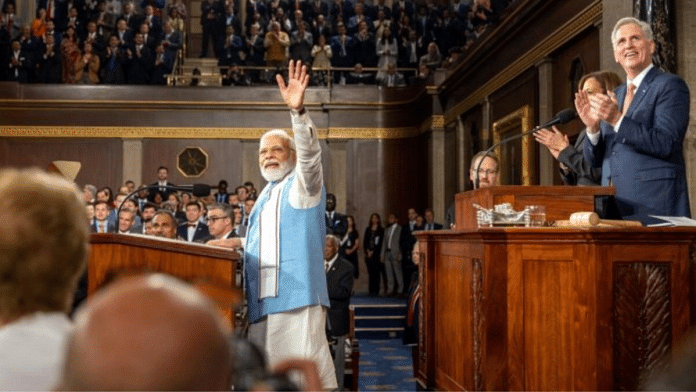Indian Prime Minister Narendra Modi returned to New Delhi Monday following what can be described as a triumphant maiden ‘official state visit’ to the United States. That this was perhaps the most crucial bilateral engagement between the two countries in years was evident by the expansive 58-paragraph joint statement issued toward the business end of PM Modi’s three-day visit.
“No corner of human enterprise is untouched by the partnership between our two great countries, which spans the seas to the stars,” it read.
Even as policy wonks pore over the joint statement and diplomacy experts hail PM Modi’s bonhomie with US President Joe Biden and his second address to a joint session of the US Congress, the resounding success of the summit underlines two key aspects of Washington’s ties with New Delhi.
First, bilateral ties between the two countries no longer hinge on a common adversary (read China). Second, and more importantly, the unstoppable momentum in this ‘comprehensive and global strategic partnership’ is being driven by people-to-people ties.
Also read: India-US ties have found the momentum. Over to PM Modi now
See the bigger picture
To say that these ties are merely cultural would be painting half the picture since the Indian diaspora’s contributions to the American economy are there for all to see, especially in the tech sector where they are a force to reckon with.
According to a report published by the Washington-based Migration Policy Institute, Indians “participate in the labour force at higher rates than all immigrants and the US born”.
It is also important to note here that apart from the constant intermingling of culture and interests, the partnership between India and the US is based on a shared belief in democracy, rule of law, meritocracy, individual rights, universalism, and entrepreneurship.
Both Americans and Indians have a strong “frontier” mindset that entails taking massive risks while exploring new frontiers in search of personal growth, economic output, or adventure.
These shared beliefs and common interests are among the factors that have made the US India’s biggest trading partner. Data from the Indian commerce ministry shows that bilateral trade between the two countries stood at $128.55 billion in 2022-23.
And PM Modi’s ‘official state visit’ could ensure that this crucial partnership only picks up more momentum.
Besides the initiative on Critical and Emerging Technologies (iCET), the two countries have agreed to significantly enhance cooperation in key sectors, including space, defence, clean energy, and digital public infrastructure (DPI).
In his opening remarks during a one-on-one meeting with President Biden in the Oval Office, PM Modi declared: “India and the US are walking shoulder-to-shoulder from the depths of the ocean to heights of the sky, from ancient culture to artificial intelligence.” President Biden, in turn, gifted PM Modi a T-shirt that read “The future is AI — America and India”.
The two countries also reached an agreement to terminate six disputes at the World Trade Organization (WTO), followed by New Delhi’s decision to remove retaliatory tariffs on 28 American products.
Also read: Modi’s US visit is everything China hates. It even called Biden’s optimism ‘wishful thinking’
The dragon in the room
One cannot, however, deny that China still factors into the considerations in the sphere of India-US ties.
President Biden, while addressing a joint press conference alongside PM Modi, emphasised that democracy is the “DNA” of both nations. While he did not name China, the contrast he was hinting at was crystal clear.
PM Modi, too, made veiled references to China in his address to the joint session of the US Congress. “The dark clouds of coercion and confrontation are casting their shadow in the Indo-Pacific,” he said, adding that progress in the region should not be “suffocated by impossible burdens of debt” and connectivity in the region must not be “leveraged for strategic purposes”.
On the idea of whether the White House views India as a “counterweight” to China, US National Security Council (NSC) Coordinator for Strategic Communications John Kirby maintained that PM Modi’s visit was not a “messaging opportunity” to China. It was the “mutual challenges with the PRC in the Indo-Pacific” that were part of the discussions between the two countries, he said.
On its part, the Chinese State media quoted analysts as saying that Washington’s “intention to rope in India to counter China and Russia” was mere “wishful thinking”.
But the writing is on the wall — while Beijing is, and will continue to be, a factor, the India-US ties have outgrown the need to counterbalance a shared adversary in the form of China.
The two countries and their peoples are beginning to grasp how their shared beliefs and economic interests can power an engine that can transform the world for the better. It is this momentum that has ushered in a new era of India-US ties over the last three decades, and it is this same momentum that could very well chart a course in the time to come.
Asha Jadeja is a Silicon Valley-based entrepreneur, venture capitalist, philanthropist and a ‘change agent.’ She tweets @ashajadeja325. Views are personal.
The article is sponsored by the Motwani Jadeja Foundation.



